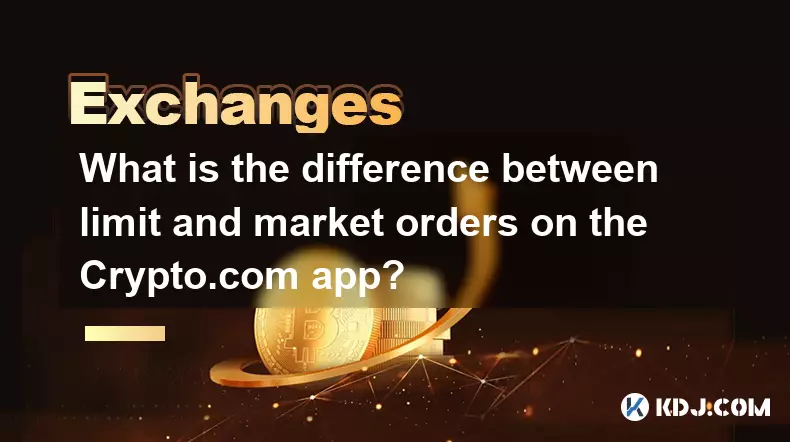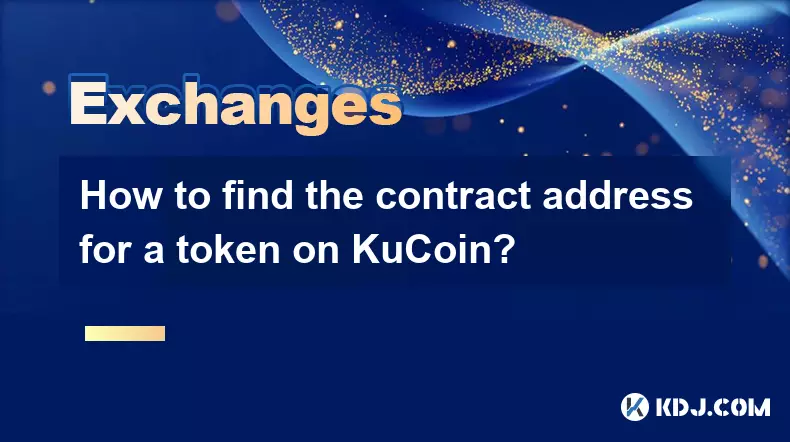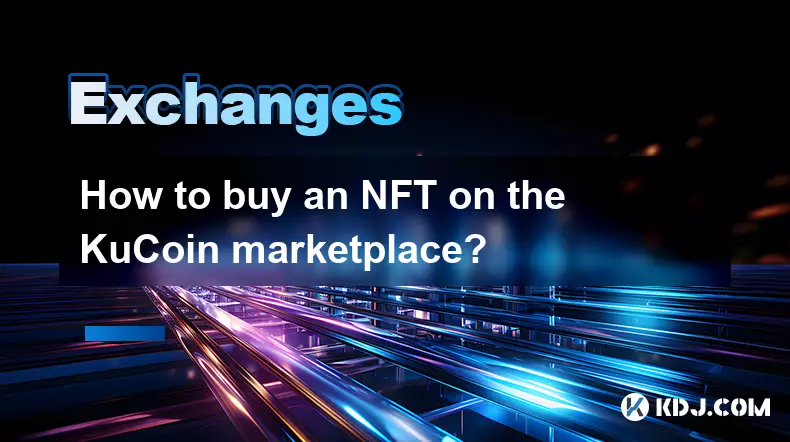-
 bitcoin
bitcoin $122090.672462 USD
1.59% -
 ethereum
ethereum $4493.758974 USD
0.56% -
 xrp
xrp $3.033145 USD
0.65% -
 tether
tether $1.000629 USD
0.00% -
 bnb
bnb $1169.854250 USD
7.07% -
 solana
solana $230.954786 USD
-0.19% -
 usd-coin
usd-coin $0.999785 USD
0.00% -
 dogecoin
dogecoin $0.256108 USD
-1.12% -
 tron
tron $0.342333 USD
-0.12% -
 cardano
cardano $0.859632 USD
-0.10% -
 hyperliquid
hyperliquid $48.932146 USD
-2.25% -
 chainlink
chainlink $22.345466 USD
-1.29% -
 ethena-usde
ethena-usde $1.000217 USD
-0.03% -
 avalanche
avalanche $31.203456 USD
1.93% -
 sui
sui $3.579145 USD
1.05%
What is the difference between limit and market orders on the Crypto.com app?
Market orders on Crypto.com execute instantly at the best available price, prioritizing speed over precision, ideal for fast trades but prone to slippage in volatile or low-liquidity markets.
Sep 28, 2025 at 11:54 am

Understanding Market Orders in the Crypto.com App
1. A market order executes a trade immediately at the best available current price on the order book. This type of order prioritizes speed over price precision, ensuring that the transaction completes as quickly as possible. Traders use market orders when they want immediate execution, especially during fast-moving market conditions.
2. Since market orders take the existing liquidity from the order book, they often result in slippage—particularly in markets with low volume or high volatility. Slippage occurs when the executed price differs from the expected price at the time the order was placed. For large trades, this discrepancy can be significant.
3. On the Crypto.com app, placing a market order is straightforward: users select the cryptocurrency, choose “Market” as the order type, specify the amount to buy or sell, and confirm the transaction. The app displays an estimated cost before confirmation, though the final price may vary slightly due to real-time market movements.
4. Market orders are ideal for traders who prioritize immediacy. They are commonly used when entering or exiting positions quickly, such as reacting to breaking news or sudden price swings. However, because they don’t allow price control, they may not be suitable for strategies requiring precise entry or exit points.
The Mechanics of Limit Orders on Crypto.com
1. A limit order allows traders to set a specific price at which they are willing to buy or sell a cryptocurrency. The trade will only execute when the market reaches that predefined price. This gives users greater control over their transaction costs and helps avoid unfavorable pricing.
2. If a buy limit order is placed below the current market price, it may never fill unless the price drops to meet the specified level. Conversely, a sell limit order above the current price waits for the market to rise before executing. This makes limit orders useful for targeted price strategies, such as accumulating assets at support levels or taking profits at resistance zones.
3. On the Crypto.com platform, users access limit orders through the trading interface by selecting “Limit” instead of “Market.” They then input the desired price and quantity. The order remains open until the conditions are met or the user cancels it. Partial fills are possible if only part of the order matches available liquidity at the set price.
4. Limit orders contribute to market liquidity when placed on the order book and are not immediately filled. These are considered 'maker' orders and often qualify for lower trading fees on platforms that reward liquidity providers.
Comparing Execution and Control
1. Market orders guarantee execution but not price, while limit orders guarantee price but not execution. This fundamental distinction shapes how traders approach different market scenarios. Those needing certainty in timing opt for market orders; those focused on price accuracy prefer limits.
2. In highly liquid markets like Bitcoin or Ethereum, market orders typically experience minimal slippage due to deep order books. However, for less-traded altcoins, the same order type could lead to substantial deviations from expected prices, making limit orders a safer choice.
3. Traders using technical analysis often rely on limit orders to automate entries and exits based on chart patterns, moving averages, or Fibonacci levels without constant monitoring.
4. The Crypto.com app provides real-time order book data, helping users assess spread and depth before deciding between market and limit options. Understanding these dynamics enables more informed decision-making and reduces the risk of unexpected outcomes.
Fees and Order Matching Logic
1. Crypto.com applies different fee structures based on order type. Market orders are classified as taker orders because they remove liquidity from the market, usually incurring higher fees. Limit orders that add liquidity (maker orders) often receive discounted rates or rebates, depending on the user’s tier status.
2. The exchange uses a price-time priority matching system. This means that among orders at the same price level, the one placed earliest gets priority. For limit orders sitting on the book, this emphasizes the importance of timing when competing for execution.
3. Advanced traders combine both order types strategically. For example, they might use a market order to enter a position quickly during a breakout and place a limit order to secure profits at a target level. This hybrid approach balances speed with precision.
4. Users should review the fee schedule within the app settings to understand exact costs associated with their trading activity. Fee differences between maker and taker orders can accumulate significantly over time, especially for high-frequency traders.
Frequently Asked Questions
Can I cancel a market order after it’s placed on Crypto.com?Once a market order is submitted, it executes almost instantly due to its nature of filling at the best available price. Therefore, cancellation is generally not possible unless there's a brief delay in processing, which is rare.
Do limit orders expire on the Crypto.com app?Yes, limit orders can be set with different time-in-force options. By default, they remain active until canceled (Good 'Til Canceled), but users can also choose to have them expire at the end of the day or after a specified period if supported by the interface.
Why did my limit order not fill even though the price appeared to reach my level?Market data displays last traded prices, which may not reflect the actual bid-ask spread at any given moment. If insufficient matching orders exist at your specified price, or if the price only briefly touched your level without sustained trading, the order may remain unfilled.
Are stop-loss orders available on Crypto.com?Crypto.com supports stop-limit orders, where a limit order is triggered once a stop price is reached. This allows users to define both the activation point and the execution price, offering more control than a simple stop-market order, which could suffer from slippage.
Disclaimer:info@kdj.com
The information provided is not trading advice. kdj.com does not assume any responsibility for any investments made based on the information provided in this article. Cryptocurrencies are highly volatile and it is highly recommended that you invest with caution after thorough research!
If you believe that the content used on this website infringes your copyright, please contact us immediately (info@kdj.com) and we will delete it promptly.
- BlockDAG, DOGE, HYPE Sponsorship: Crypto Trends Shaping 2025
- 2025-10-01 00:25:13
- Deutsche Börse and Circle: A StableCoin Adoption Powerhouse in Europe
- 2025-10-01 00:25:13
- BlockDAG's Presale Buzz: Is It the Crypto to Watch in October 2025?
- 2025-10-01 00:30:13
- Bitcoin, Crypto, and IQ: When Genius Meets Digital Gold?
- 2025-10-01 00:30:13
- Stablecoins, American Innovation, and Wallet Tokens: The Next Frontier
- 2025-10-01 00:35:12
- NBU, Coins, and Crypto in Ukraine: A New Yorker's Take
- 2025-10-01 00:45:14
Related knowledge

How to close my position in KuCoin Futures?
Oct 01,2025 at 07:54pm
Understanding Position Closure in KuCoin FuturesTrading futures on KuCoin requires a clear understanding of how to manage open positions. Closing a po...

How to find the contract address for a token on KuCoin?
Sep 30,2025 at 09:00pm
Finding the Contract Address on KuCoin1. Log into your KuCoin account through the official website or mobile application. Navigate to the 'Markets' se...

How to set up SMS verification on my KuCoin account?
Oct 03,2025 at 12:36am
How to Enable SMS Verification on Your KuCoin AccountSecuring your cryptocurrency exchange account is essential, especially on platforms like KuCoin w...

How to update the KuCoin app to the latest version?
Oct 03,2025 at 02:18am
How to Update the KuCoin App: A Step-by-Step GuideKeeping your KuCoin app updated ensures access to the latest security features, trading tools, and u...

How to buy an NFT on the KuCoin marketplace?
Oct 02,2025 at 10:19pm
Accessing the KuCoin NFT Marketplace1. Log in to your KuCoin account through the official website or mobile application. Ensure that two-factor authen...

How to create a sub-account on KuCoin?
Oct 03,2025 at 10:18pm
Accessing the KuCoin Dashboard1. Navigate to the official KuCoin website and log in using your registered email and password. Two-factor authenticatio...

How to close my position in KuCoin Futures?
Oct 01,2025 at 07:54pm
Understanding Position Closure in KuCoin FuturesTrading futures on KuCoin requires a clear understanding of how to manage open positions. Closing a po...

How to find the contract address for a token on KuCoin?
Sep 30,2025 at 09:00pm
Finding the Contract Address on KuCoin1. Log into your KuCoin account through the official website or mobile application. Navigate to the 'Markets' se...

How to set up SMS verification on my KuCoin account?
Oct 03,2025 at 12:36am
How to Enable SMS Verification on Your KuCoin AccountSecuring your cryptocurrency exchange account is essential, especially on platforms like KuCoin w...

How to update the KuCoin app to the latest version?
Oct 03,2025 at 02:18am
How to Update the KuCoin App: A Step-by-Step GuideKeeping your KuCoin app updated ensures access to the latest security features, trading tools, and u...

How to buy an NFT on the KuCoin marketplace?
Oct 02,2025 at 10:19pm
Accessing the KuCoin NFT Marketplace1. Log in to your KuCoin account through the official website or mobile application. Ensure that two-factor authen...

How to create a sub-account on KuCoin?
Oct 03,2025 at 10:18pm
Accessing the KuCoin Dashboard1. Navigate to the official KuCoin website and log in using your registered email and password. Two-factor authenticatio...
See all articles










































































